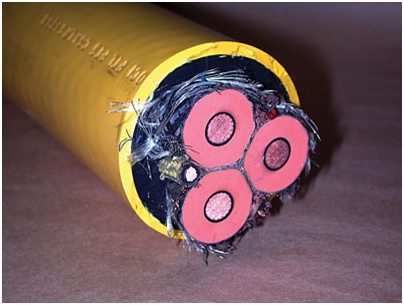
Other than the core electrically conducting material, cable construction consists of non-conducting materials for functionality and aesthetics.
Insulators separate conductors to prevent short-circuits, as well as offer safeguard individuals. For this reason, the material must be able to contain the current within the required region. The common materials used include paper, rubber, and elastomers. Their individual properties are highlighted below.
Paper Insulation
This is the oldest form of cable insulation, and is still in use for medium voltage systems. The setting includes a tight wrapping of insulating fluid-impregnated paper, followed by a thin lead sheath to provide moisture resistance. Benefits include low dielectric losses, resistance to detriments associated with DC testing, and a verifiable history of reliability.
However, the dielectric features moisture degradation, difficulty in repair, high cost, and high weight due to a large volume of paper required.
Rubber
Rubber was one of the most used non-conducting materials traditionally in electricity. It occurs in two forms, natural and synthetic rubber. Natural rubber, sourced from the Hevea brasiliensis tree, is of minimal use in its natural form.
Vulcanization and curing include additives such as sulfur, carbon black, and others under heat and pressure. Sulfur adds tensile strength, while carbon filler reduces dielectric strength, resulting to an effective insulator.
Synthetic rubber, on the other hand, involves combination of carbon, hydrogen and other molecules for a material that is similar to natural rubber. The nature and combination of additions determines basic characteristics, applications and temperature range.
Elastomers
An ‘elastomer’ is the most appropriate term for rubber, given the composition and elastic property. However, a number on non rubber-based elastomers exhibit similar properties and include thermo-plastics and thermosets.
Commonly referred to as plastics, the two are in widespread use in electrical cables and components due to the ease of manufacture and impressive insulation properties. The primary feature of plastics is that they are synthetically manufactured from derivatives of natural compounds such as crude oil, hydrocarbons, and natural gas.
Thermoplastic retain their flexibility, as well as chemical composition with an instant application and removal of heat. The material, however, melts under extended and steady heat application. For this purpose, other materials are added to improve the insulation properties including high dielectric strength, insulation resistivity, high melting temperature and low dielectric loss, amongst others.
The most common thermoplastic for cable insulation is PVC due to relatively low cost, durability, and accessibility. However, under extended heat application, byproducts such as chlorine lead to toxic fumes, which can be dangerous in confined places such as shafts and tunnels.
Other thermoplastics in use include polyethylene (PE), which features lower dielectric losses than PVC, and voltage stress in the presence of moisture. However, PE tends to be hard and stiff, therefore is not appropriate for winding installations.
Thermosets are different from thermoplastics in that heat application and removal leads to irreversible changes. The common types used in cables include cross-linked polyethylene (XLPE) and ethylene propylene (EPR).
Due to the property highlighted (irreversible change after heat application and removal), thermosets are used for sheet insulation, cable-jointing compounds, and post insulators.
The importance of insulation in electrical cables cannot be overemphasized. Conductor integrity, safety, as well as effectiveness depend on the nature of the chosen material. Do note that there are further variants of the above materials for varied and specialized uses.
However, to achieve the required features, ensure that you select the right material for the application.
What do you think of that article? Feel free to give us your impressions!


